Melasma is a skin condition characterized by dark, hyperpigmented patches, commonly on the face. These spots can be brown, tan, or bluish-grey, often resembling freckles. It is more common in women, but it can also occur in men. Pregnant women get it the most. Estimates suggest that melasma affects a significant number of pregnant women That is why it is also known as the “mask of pregnancy.”
Melasma can be a persistent skin condition, and while it may subside on its own, especially post-pregnancy, it can also last for years or be lifelong.
Melasma is generally not indicative of a serious health condition and is not life-threatening. But, visible melasma spots can impact facial aesthetics, potentially causing emotional distress and affecting self-esteem.
Table of Contents
- 1 What are the Symptoms of Melasma?
- 2 Types of Melasma
- 3 Causes and Risk Factors
- 4 Diagnosis
- 5 Treatment Options for Melasma
- 6 Before & After
- 7 Melasma Treatment Cost in Dubai
- 8 Why is Sun Protection essential for managing Melasma?
- 9 Is there a permanent cure for melasma?
- 10 Can you treat melasma during pregnancy?
- 11 Birth control pills causing melasma, what to do?
- 12 Our Doctors
- 13 Schedule A Consultation
What are the Symptoms of Melasma?
Melasma is identified by blotchy, hyper-pigmented patches that appear darker than your skin tone. Melasma commonly appears on the cheeks, forehead, bridge of the nose, and chin. It can also occur, though less frequently, on the neck and arms. Other common signs and symptoms include the following
- Melasma patches are often symmetric, developing on both sides of the face. However, asymmetric cases, where it appears only on one side, are also possible.
- They can be more prominent in some areas than others (e.g., they might be more noticeable on the cheeks, nose, or jawline than in other facial areas).
- They may cover a sizeable facial skin area, appearing as one large patch or several small spots.
Types of Melasma
Melasma can be classified into three types based on the melanin deposition in the skin layers.
- Epidermal Melasma: This type of melasma is identified by a well-defined border and the dark brown color of the spots. It usually appears more prominently under the Wood’s lamp (a tool that emits UV-A light or blacklight).
- Dermal melasma: This type is usually blue-grey and has an ill-defined border. It is less responsive to treatment and does not enhance under Wood’s lamp.
- Mixed Melasma: This type is the most common and is usually identified by a combination of dark or light brown and bluish-grey patches. When viewed under black light, it may show mixed patterns.
Causes and Risk Factors
Exactly what causes melasma is yet to be established. However, researchers have found that in people suffering from melasma, the cells that give the skin its color, called melanocytes, are often more active than usual. This strengthens the theory that melasma may develop when something causes melanocytes to go into overdrive.
Several factors are known to trigger or worsen melasma, including:
- Pregnancy: The risk of melasma is the highest in pregnant women. The increased levels of estrogen and progesterone during pregnancy are believed to contribute to the development of melasma.
- Sunlight: Sunlight exposure can increase melanin production, heightening the risk of developing or exacerbating melasma. This explains why areas that get the most sunlight, like the face, neck, and arms, are more likely to develop melasma.
- Stress: While stress, leading to higher levels of cortisol, is speculated to be a trigger for melasma, its role is not definitively established and requires further research.
- Certain medications: Birth control pills, anti-seizure medications, and drugs that increase skin’s sensitivity to sunlight have been found to trigger melasma in some people.
- Tanning beds: Tanning beds expose the skin to more concentrated UV rays than sunlight. This can lead to higher melanin production, increasing the melasma risk.
- Thyroid disease: A problem with the thyroid has been found to increase the risk of melasma in some cases.
- Treatment-induced hormonal changes: Hormonal changes due to hormone replacement therapy (HRT) or oral contraceptives can increase the risk of developing melasma.
The following factors are also thought to be associated with a higher risk of melasma
- Being a woman aged between 20 and 40.
- Individuals with medium to dark skin tones are more prone to developing melasma due to higher melanin content.
- A family history of melasma increases the risk of developing the condition.
Diagnosis
Dermatologists use multiple measures to diagnose melasma. Here is a brief overview of some standard diagnostic techniques
- A clinical examination – A dermatologist can often diagnose melasma based on its characteristic appearance. It may involve using a dermatoscope to examine the affected area closely. The doctor may also inquire about the patient’s personal or family history to evaluate their overall susceptibility to developing melasma.
- Wood’s Lamp – This diagnostic tool uses UV light to better visualize and assess the depth of pigmentation changes associated with melasma.
- Thyroid checkup – Your doctor may want to check your thyroid if you have dark, blotchy spots on your face. This is because there is a link between thyroid disease and melasma.
- Skin biopsy – Sometimes, the spots caused by melasma look like those from other skin conditions, so it can be hard to tell them apart. In uncertain cases, a skin biopsy may be performed to differentiate melasma from other skin conditions causing dark spots.
- Melasma Area and Severity Index (MASI) – It is a tool used by clinicians to quantify the severity and area of melasma, aiding in treatment planning and monitoring.
Treatment Options for Melasma
While there is no permanent cure for melasma, treatments are available to manage and reduce its appearance. The effectiveness of melasma treatments can vary, emphasizing the importance of seeking care from a qualified dermatologist.
Let’s briefly look at some of the most common treatment options for melasma.
Topical Creams
For patients with melasma, dermatologists often recommend creams that contain Hydroquinone (HQ). Topical creams aim to lighten the skin by targeting hyperpigmentation.
Other agents used in topical creams for melasma include:
- Kojic acid
- Azelaic acid
- Topical steroids
- Retinoids
- Mequinol
- Glycolic acid
- Arbutin
Chemical Peels
Chemical peeling can be an effective option to reduce the appearance of melasma spots. This procedure involves applying a peeling solution to the skin, which exfoliates the top skin layer. Chemical peels can be effective for epidermal melasma, helping to lighten the affected skin areas. Chemical peels are less effective for dermal melasma, which involves deeper layers of the skin and is more resistant to superficial treatments.
Microdermabrasion
Microdermabrasion generally involves using a handheld device that sprays tiny crystals onto the skin, exfoliating the top skin layer. Microdermabrasion can assist in reducing the appearance of dark spots, including those caused by melasma, through exfoliation. Microdermabrasion can be more effective when used in conjunction with other treatments, such as topical creams or oral medications.
Laser Treatment
Laser treatments can be an option for melasma that is resistant to topical treatments and chemical peels, though results can vary. Laser therapy for melasma involves targeting the pigmented areas with specific wavelengths of light to break down excess melanin and promote skin rejuvenation.
Common laser treatments for melasma include:
- Pico Lasers
- Fraxel (fractional) lasers
- Q-Switched ND: YAG (532 nm, 1064nm)
- 755 nm Q-switched alexandrite laser (QSAL)
Before & After
Results of melasma treatment can vary widely among individuals, and no specific outcome can be guaranteed.
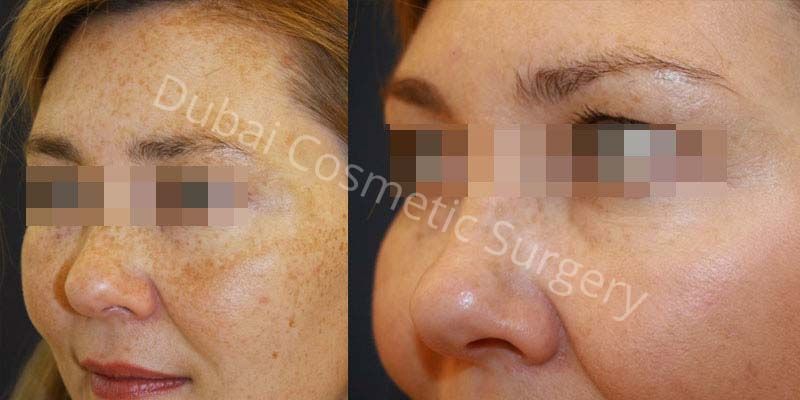
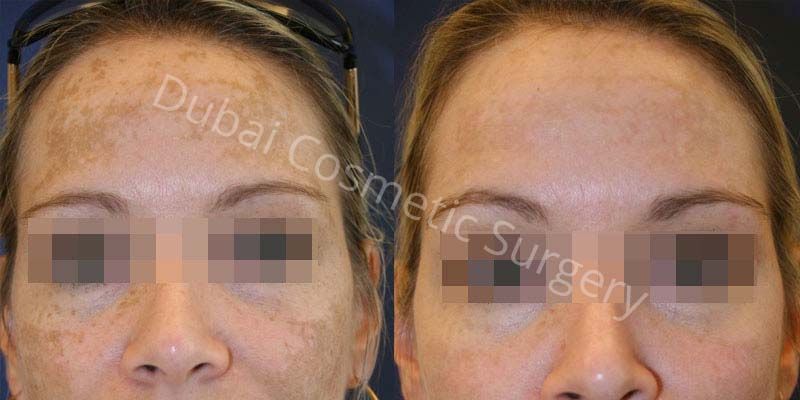
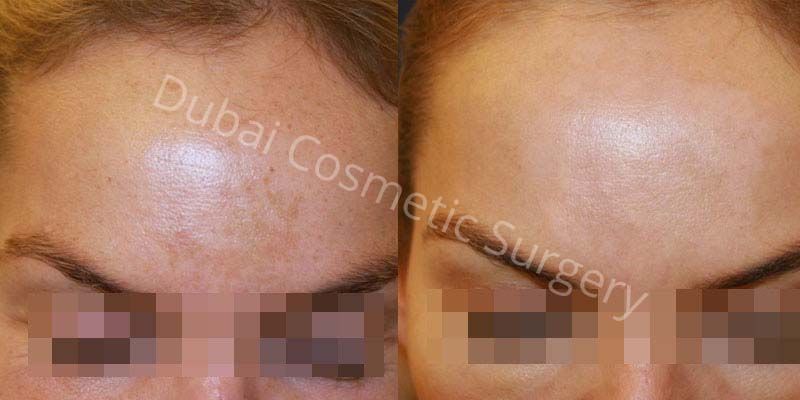
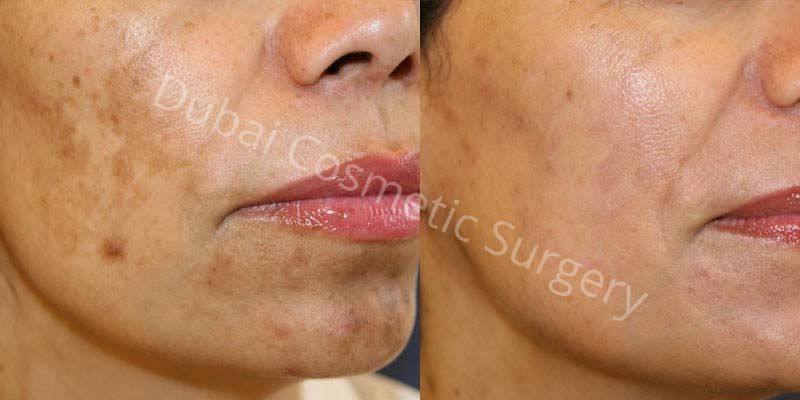

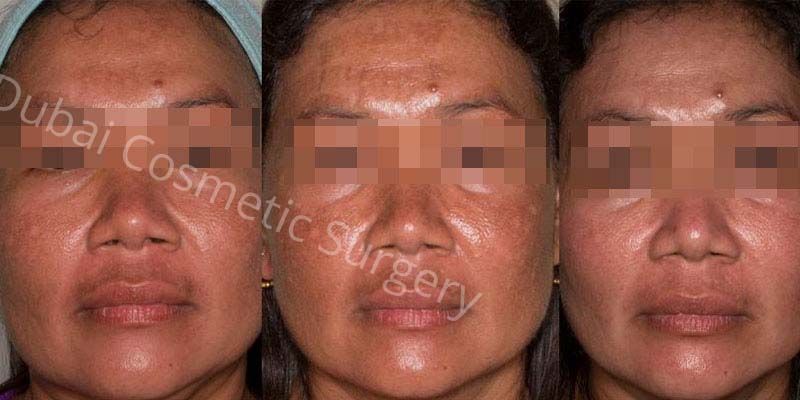
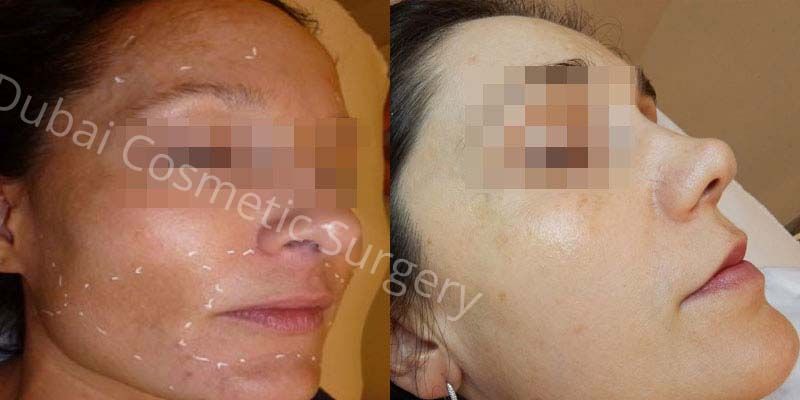
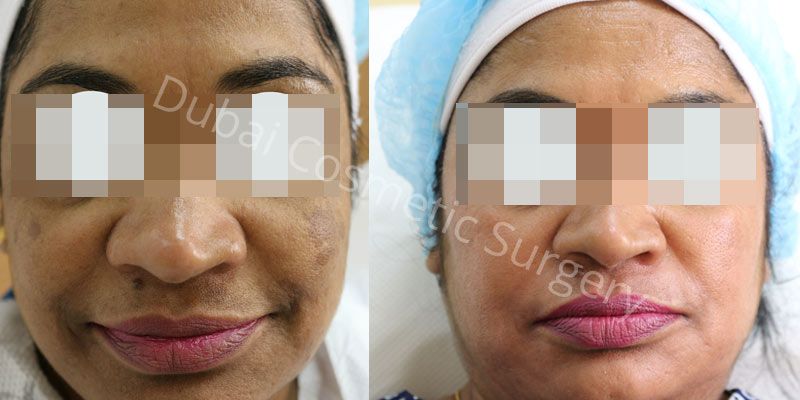
Melasma Treatment Cost in Dubai
The cost of melasma treatment varies depending on the chosen treatment type, extent of the condition, and the number of sessions required. The average starting price of laser melasma treatment in Dubai is AED 3500. Consult with our dermatologist to get a personalized estimate and treatment plan tailored to your specific case of melasma.
Why is Sun Protection essential for managing Melasma?
Sunlight can stimulate melanin production, potentially darkening the existing melasma spots and forming new melasma patches.
Your dermatologist will likely give you a set of guidelines for adequate sun protection. Effective sun protection is crucial in managing melasma and may include
- Wear a wide-brimmed hat for added sun protection when outdoors, especially during peak sunlight hours.
- Use a broad-spectrum sunscreen of SPF 30 or higher, preferably containing physical blockers like zinc oxide or titanium dioxide, and consider formulations with iron oxide for additional visible light protection.
Is there a permanent cure for melasma?
Unfortunately, no treatments can guarantee a permanent cure for melasma. However, many treatments are available to manage the condition.
Can you treat melasma during pregnancy?
Treating melasma during pregnancy should be approached with caution, and certain treatments may be deferred until post-pregnancy. Certain melasma treatments may contain ingredients or involve procedures that are not recommended during pregnancy.
Birth control pills causing melasma, what to do?
If you are concerned about melasma risk with birth control pills, discuss alternative options like the mini-pill with your healthcare provider. It is a progestin-only pill that doesn’t contain estrogen. Its use is less likely to trigger melanin overproduction and cause melasma. That being said, speaking to your doctor before switching to this pill is essential.
Our Doctors
Schedule A Consultation
If melasma is affecting your quality of life, consider consulting with a dermatologist to explore treatment options. Consult with our expert dermatologists to explore a range of treatment options tailored to your specific case of melasma. For details, call +971 4 348 5575. To book a consultation online, fill out the form below.
Fill in the form to get a consultation
100% Financing with 0% Interest

